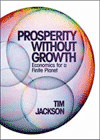Mindfulness and Compulsive Buying
Overall aims and context
Excessive consumption of goods and resources in developed countries is seen as a key contributor to a number of environmental problems, particularly climate change. Reducing consumption decreases environmental impacts, and should be encouraged as part of a larger strategy of seeking sustainable lifestyles. A type of ‘excessive’ consumer considered in this research is the compulsive buyer, someone who is addicted to buying and shopping.
This study explores the concept of mindfulness as a distinctive way of thinking and being, through which human wants and needs can be met by beginning to shift default perspectives around excessive material consumption. It is suggested that the emphasis on non-judgemental awareness of the present moment (rather than planning for the future or analysing the past) can enable a change in consumption behaviour as an outcome rather than an aim – a process which is less likely to leave individuals feeling deprived. Consistent practice has been shown to be effective at reducing the incidence of the maladies that might lead individuals to turn habitually to materialist solutions, i.e. for depression, anxiety, anomie, a weak sense of self and community, and low efficacy and control. By training compulsive buyers in mindfulness, they may increase their general sense of wellbeing, and tolerance of negative affect, thereby removing many drivers for buying. And they may become aware of the urges to spend as they occur and to choose their behaviour rather than acting habitually.
Research Questions & Methods
The research questions focussed on measurement of the effectiveness, and exploration of the experiences of an intervention in the form of an eight-week Mindfulness-Based Stress Reduction course. The nineteen participants were divided between an experimental group and two controls. Twelve participants took part in the course, half of who were self-confessed compulsive buyers (experimental group) and the other half were “normal” shoppers (control group). The remaining seven compulsive buyers did not take part in the course (control group). Interviews of the experimental group were conducted before, after and two months after the intervention. Quantitative data were collected from all three groups.
Results
The results show a marked decrease in factors that may be causing and maintaining the compulsive buying such as depression, anxiety, and obsessive-compulsive tendencies. An increase to buffering qualities was also observed, such as to mindfulness, self-esteem, positive affect and decentring. The experimental group participants described their experiences, telling of their increased ability to face the reality of their lives and not use shopping as an escape. They have a greater sense of who they are, and what they really need on psychological and material levels. And they feel stronger and more able to understand the triggers for shopping urges, and to choose moment by moment whether they will indulge those urges.
Implications
This work offers a compelling argument for more widespread use in the practice of mindfulness in reducing the behaviours, habits and lifestyles around buying and consuming, while encouraging an associated increase in individual wellbeing and potential lowering of negative environmental impact. It is suggested that life becomes richer through doing less, but being more.
Output
Armstrong, A J, B Gatersleben and T Jackson 2009. Can mindfulness help reduce consumption? Paper presented at the 8th Biennial Conference on Environmental Psychology, Zurich, Switzerland.
Armstrong, A J, B Gatersleben and T Jackson 2012. Can mindfulness help reduce consumption? In T Jackson and I Christie (Eds) Lifestyles, Values and the Environment. London: Earthscan/Taylor and Francis (forthcoming).
See also:
Armstrong, A and T Jackson 2015. The Mindful Consumer. Mindfulness training and the escape from consumerism. Friends of the Earth, Big Ideas.





